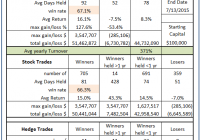Market Beginners Portfolio – July Update
Summary The Market Beginners Portfolio has had a difficult time over the past few months. The portfolio has significant potential for future growth. I chose to invest in Frontier Communication Corporation because of the future opportunity it provides. Introduction As many of my subscribers know, I have written a large number of portfolios talking for a variety of different goals. However, the original Market Beginners Portfolio represented my first attempt at creating a portfolio designed for someone incorporating multiple different points of view. The overall goal of this portfolio is to create a sample portfolio for someone with $100,000 to invest. The portfolio will be composed of both ETFs and Individual Stocks designed to maximize both safety and income for the portfolio. However, rather than focusing on just income for the portfolio, I will also be focusing on overall stock growth. This portfolio is centered towards overall growth and that involves growth both in the form of income and portfolio value. Rules Discipline is the backbone of any major portfolio. As a result, any good portfolio requires at least a few rules to help keep things in balance. This portfolio has two. The first rule is no new money may be added to the portfolio. While this is not a restriction most people generally face, it is helpful for managing a portfolio and as a result is a rule I include in most of my portfolios. The second rule is that no stock or ETF may make up more than 20% of the portfolio. While having different ETFs or secure stocks may help with the portfolio’s safety, minimizing your positions in different stocks helps to maintain your portfolio’s security. Portfolio Stock Name (Ticker) Number of Shares Purchase Price Current Price Johnson & Johnson (NYSE: JNJ ) 100 $100.55 $100.09 Chevron (NYSE: CVX ) 100 $107.70 $93.14 Pimco Strategic Income Fund (NYSE: RCS ) 1000 $9.19 $8.49 Bank of America (NYSE: BAC ) 1000 $16.47 $18.10 Monsanto Company (NYSE: MON ) 100 $118.25 $107.07 Vanguard Total Stock Market ETF (NYSEARCA: VTI ) 100 $108.73 $109.96 Vanguard Dividend Appreciation ETF (NYSEARCA: VIG ) 200 $81.18 $80.77 Original Portfolio Value: $85,430 Total Cash: $14,570 Current Portfolio Value: $83,770 Current Cash: $14,570 Change In Portfolio Value: -1.94% Portfolio Discussion The portfolio has had a relatively difficult time – it has lost 1.94% over the past few months. Much of this loss is due to a decrease in the prices of Chevron, Pimco Strategic Income Fund, and Monsanto Company. However, the portfolio has done an impressive job in Bank of America seeing that position increase by almost $2000. This helped offset some of the other more significant losses for the portfolio. As for decisions, I am choosing to keep the portfolio relatively simple. However, at this time I am making a 1000 share purchase in Frontier Communications Corporation (NASDAQ: FTR ) at $5.14 per share. That takes the cash position of the portfolio down to $9430. Frontier Communications Corporation is a solid company that has had a difficult time dropping from $8.42 earlier in the year. However, management at the company is solid and the company offers a 8.17% dividend at current prices. Cash I continue to hold a significant cash stake in the portfolio amounting to almost 10% of its assets. Future dividends should help to increase the portfolio’s cash position. The market is currently near all time highs and I am hoping to be able to let the portfolio’s cash position grow until better opportunities can be identified. Conclusion The portfolio has had a difficult time recently losing almost 2% of its value. Despite significant losses in other regions, the portfolio managed to make some of the losses back due to a significant increase in the value of Bank of America. I also chose to invest in Frontier Communications Corporation this month. The company has had a difficult time in recent months and as a result now offers a significant dividend amounting to over 8%. I hope to see this portfolio recover and continue growing in future months. Disclosure: I/we have no positions in any stocks mentioned, and no plans to initiate any positions within the next 72 hours. (More…) I wrote this article myself, and it expresses my own opinions. I am not receiving compensation for it (other than from Seeking Alpha). I have no business relationship with any company whose stock is mentioned in this article.
